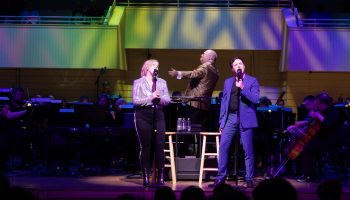In 1977, the Voyager spacecrafts 1 and 2 launched into space, carrying with them sounds of Beethoven’s String Quartet No. 13, Op. 130, in B flat major.
NASA sent the Golden Records — which included music from around the globe, spoken greetings in a variety of languages and sounds of nature — floating into space as a sort of time capsule intended to represent the life and culture on Earth to any other intelligent life forms that may find it.
The Chautauqua Quartet, set to perform at 4 p.m. Monday in Elizabeth S. Lenna Hall as part of the Logan Chamber Music Series, decided to play this piece by Beethoven because, according to viola player Eva Stern, it made complete sense during a week themed “Our Search for Another Earth.”
“It was sent out into space to represent humanity to whomever might be out there,” said Vahn Armstrong, first violinist in the Chautauqua Quartet.
The appropriateness of performing the Beethoven piece does not stop there, Armstrong said.
The Chautauqua Quartet dedicated this movement, often played as a memorial, to Kay Logan, creator and supporter of the chamber music series, who passed away recently.
Armstrong said the chosen selection, from Beethoven’s collection of “later quartets,” has a light, lyrical and happy tone. He said the quartet displays a side of Beethoven that symphonies don’t often play.
“The late quartets are not so well known,” Armstrong said. “I think everybody knows about them, but a lot of people, even musicians, even string players, don’t know them so well. I think they are a little intimidating, but they are absolutely wonderful.”
Beethoven wrote alternate endings to the piece, Armstrong said. He described one as very intense and representative of a big feud. The other one, which the quartet will play today, offers a lighter, happier conclusion.
Cellist Jolyon Pegis said String Quartet No. 8, Op. 110, the other piece the quartet will perform, plays as an autobiographical work of composer Dmitri Shostakovich.
Note names can be much more than the audience initially realizes, Armstrong said. He explained that American note names (A,B,C,D,E,F,G) differ from German note names.
In the German system E flat is called S and B natural is H. In this particular piece, the note sequence reads “D,S,C,H,” or, as Armstrong pointed out, Shostakovich’s musical initials.
Bach used the same trick, Armstrong said. He put sequences of notes in his pieces that played “B,A,C,H,” he said, or a little signature every now and then.
Diane Bruce, second violin player, said putting those note sequences into songs acts as a secret code for musicians to add an extra layer of meaning to their songs.
Armstrong said although Bach used his musical initials in pieces sparingly, Shostakovich flaunted it tremendously.
“I take it as his sort of insistence on his rights as an individual as opposed to the tyranny of the state,” Armstrong said of the Soviet composer. “He seems to be really insisting, ‘I am a person.’ ”
Armstrong said each of those pieces focuses on the aspect of questioning the nature of humanity. He said Beethoven illustrates a very attractive humanity, while Shostakovich does not shy away from the negative aspects.
“So, I guess Shostakovich is a little bit why we will need to go out into space and find another Earth,” Armstrong said.





